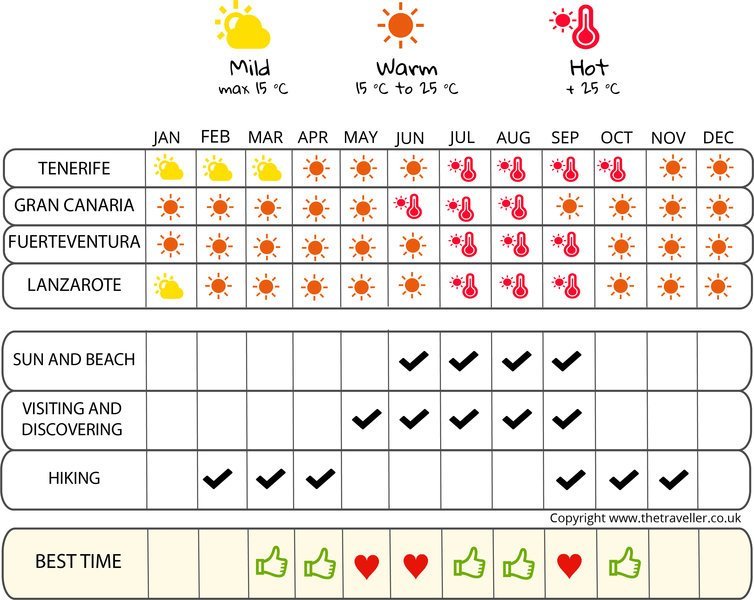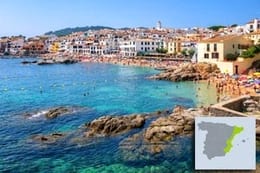When to go to the Canary Islands?

|
Temperatures Las Palmas de Gran Canaria
| Jan | Feb | March | April | May | June | Jul | August | Sept | Oct | nov. | dec. | |
|---|---|---|---|---|---|---|---|---|---|---|---|---|
| Min temperature | 15° | 15° | 16° | 16° | 18° | 19° | 21° | 22° | 21° | 20° | 18° | 16° |
| Max temperature | 21° | 21° | 23° | 23° | 24° | 26° | 27° | 28° | 27° | 26° | 24° | 22° |
| Sea temperature | 14° | 13° | 14° | 15° | 18° | 21° | 24° | 26° | 24° | 22° | 18° | 16° |
Sunshine
Rainfall Las Palmas de Gran Canaria
The weather month by month in the Canary Islands
Weather Las Palmas de Gran Canaria in January
Sea: 14 °
| 16 d/month | 8 d/month | 5 d/month | 1 day | 1 day |
In January, in Las Palmas de Gran Canaria, Minimum temperatures vary between 15 in the morning and 21 in the afternoon. The weather is sunny and Pleasant. The average rainfall is around 26 inches, for 26 days without rain.
Check the weather over the last 5 years for the dates of your stay
Weather history day by day
Weather Las Palmas de Gran Canaria in February
Sea: 13 °
| 12 d/month | 7 d/month | 6 d/month | 2 d/month | 1 day |
In February, in Las Palmas de Gran Canaria, Minimum temperatures vary between 15 in the morning and 21 in the afternoon. The weather is sunny and Pleasant. The average rainfall is around 22 inches, for 24 days without rain.
Check the weather over the last 5 years for the dates of your stay
Weather history day by day
Weather Las Palmas de Gran Canaria in March
Sea: 14 °
| 19 d/month | 6 d/month | 4 d/month | 2 d/month |
In March, in Las Palmas de Gran Canaria, Minimum temperatures vary between 16 in the morning and 23 in the afternoon. The average rainfall is around 14 inches, for 27 days without rain.
Check the weather over the last 5 years for the dates of your stay
Weather history day by day
Weather Las Palmas de Gran Canaria in April
Sea: 15 °
| 17 d/month | 8 d/month | 3 d/month | 1 day | 1 day |
In April, in Las Palmas de Gran Canaria, Minimum temperatures vary between 16 in the morning and 23 in the afternoon. The average rainfall is around 5 inches, for 28 days without rain.
Check the weather over the last 5 years for the dates of your stay
Weather history day by day
Weather Las Palmas de Gran Canaria in May
Sea: 18 °
| 18 d/month | 9 d/month | 2 d/month | 1 day | 1 day |
In May, in Las Palmas de Gran Canaria, Minimum temperatures vary between 18 in the morning and 24 in the afternoon. The average rainfall is around 4 inches, for 29 days without rain.
Check the weather over the last 5 years for the dates of your stay
Weather history day by day
Weather Las Palmas de Gran Canaria in June
Sea: 21 °
| 18 d/month | 9 d/month | 2 d/month | 1 day |
In June, in Las Palmas de Gran Canaria, Minimum temperatures vary between 19 in the morning and 26 in the afternoon. Temperatures are hot. The average rainfall is around 1 inches, for 29 days without rain.
Check the weather over the last 5 years for the dates of your stay
Weather history day by day
Weather Las Palmas de Gran Canaria in July
Sea: 24 °
| 19 d/month | 10 d/month | 1 day | 1 day |
In July, in Las Palmas de Gran Canaria, Minimum temperatures vary between 21 in the morning and 27 in the afternoon. Temperatures are hot. The average rainfall is around 0 inches, for 30 days without rain.
Check the weather over the last 5 years for the dates of your stay
Weather history day by day
Weather Las Palmas de Gran Canaria in August
Sea: 26 °
| 21 d/month | 7 d/month | 3 d/month |
In August, in Las Palmas de Gran Canaria, Minimum temperatures vary between 22 in the morning and 28 in the afternoon. Temperatures are hot. The average rainfall is around 0 inches, for 28 days without rain.
Check the weather over the last 5 years for the dates of your stay
Weather history day by day
Weather Las Palmas de Gran Canaria in September
Sea: 24 °
| 18 d/month | 8 d/month | 3 d/month | 1 day |
In September, in Las Palmas de Gran Canaria, Minimum temperatures vary between 21 in the morning and 27 in the afternoon. Temperatures are hot. The average rainfall is around 6 inches, for 27 days without rain.
Check the weather over the last 5 years for the dates of your stay
Weather history day by day
Weather Las Palmas de Gran Canaria in October
Sea: 22 °
| 14 d/month | 8 d/month | 6 d/month | 2 d/month | 1 day |
In October, in Las Palmas de Gran Canaria, Minimum temperatures vary between 20 in the morning and 26 in the afternoon. Temperatures are hot. The average rainfall is around 17 inches, for 24 days without rain.
Check the weather over the last 5 years for the dates of your stay
Weather history day by day
Weather Las Palmas de Gran Canaria in November
Sea: 18 °
| 11 d/month | 9 d/month | 8 d/month | 1 day | 1 day |
In November, in Las Palmas de Gran Canaria, Minimum temperatures vary between 18 in the morning and 24 in the afternoon. The average rainfall is around 28 inches, for 22 days without rain.
Check the weather over the last 5 years for the dates of your stay
Weather history day by day
Weather Las Palmas de Gran Canaria in December
Sea: 16 °
| 14 d/month | 9 d/month | 5 d/month | 2 d/month | 1 day |
In December, in Las Palmas de Gran Canaria, Minimum temperatures vary between 16 in the morning and 22 in the afternoon. The average rainfall is around 37 inches, for 26 days without rain.
Check the weather over the last 5 years for the dates of your stay
Weather history day by day
Influx of tourists
Temperature and climate in:
Adeje | Bajamar | Caleta del Caballo | Corralejo | Fuerteventura | Golf del Sur | Igueste | La Geria | La Oliva | Lanzarote | Las Palmas de Gran Canaria | Los Marteles | Maspalomas | Mogán | Morro de la Laja Grande | Playa de Sotavento de Jandía | Punta del Hidalgo | San Cristóbal de La Laguna | San Sebastián de La Gomera | Teide | Tenerife |





